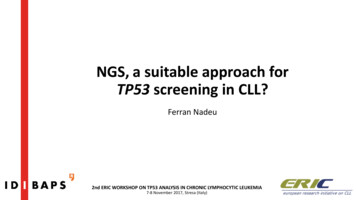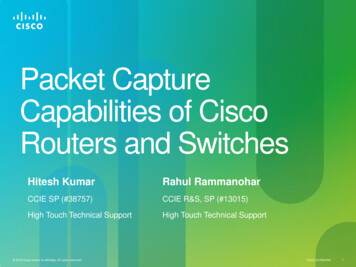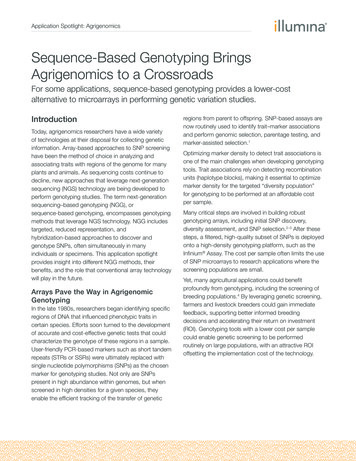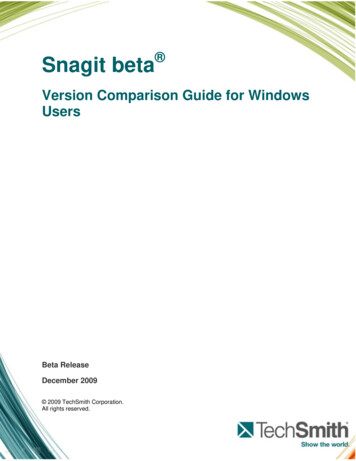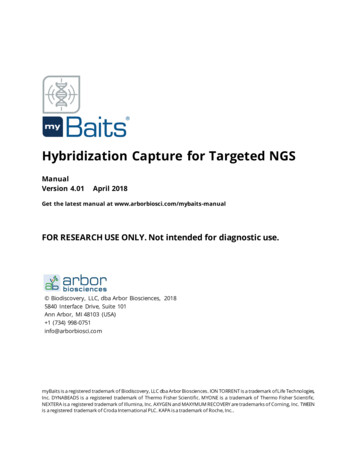
Transcription
Hybridization Capture for Targeted NGSManualVersion 4.01April 2018Get the latest manual at www.arborbiosci.com/mybaits-manualFOR RESEARCH USE ONLY. Not intended for diagnostic use. Biodiscovery, LLC, dba Arbor Biosciences, 20185840 Interface Drive, Suite 101Ann Arbor, MI 48103 (USA) 1 (734) 998-0751info@arborbiosci.commyBaits is a registered trademark of Biodiscovery, LLC dba Arbor Biosciences. ION TORRENT is a trademark of Life Technologies,Inc. DYNABEADS is a registered trademark of Thermo Fisher Scientific. MYONE is a trademark of Thermo Fisher Scientific.NEXTERA is a registered trademark of Illumina, Inc. AXYGEN and MAXYMUM RECOVERY are trademarks of Corning, Inc. TWEENis a registered trademark of Croda International PLC. KAPA is a trademark of Roche, Inc.
CONTENTSINTRODUCTIONProcedure overview3Product compatibility4Changes since the previous manual4Kit components and stability4REQUIREMENTS AND RECOMMENDATIONSEquipment and reagentsExperimental designEnriching low-copy, degraded and/or contaminated DNA libraries566PROCEDURE Part 1: Hybridization Setup1.11.21.31.4Prepare materialsHybridization Mix setupBlockers Mix setupReaction assembly7889PROCEDURE Part 2: Bind and Wash2.12.22.32.42.5Prepare materialsWash Buffer X preparationBead preparationBinding beads and hybridsBead washing1011111111PROCEDURE Part 3: Library Resuspension and Amplification3.13.23.3Prepare materialsEnriched library resuspensionLibrary e-treatment of Nextera LibrariesmyBaits Procedure Quick GuidemyBaits — Hybridization Capture for Targeted NGS — Manual v.4.01 April 20181415172
INTRODUCTIONmyBaits is an in-solution NGS library target enrichment system, compatible with Illumina , IonTorrent , and many other sequencing library types. We use a versatile nucleic acid synthesistechnology to make biotinylated RNA “baits” that are complementary to your sequence targets. Baitsand other reagents for NGS target enrichment are supplied with the myBaits kit.Procedure overview1.Sequencing library, adapter blockers,and other hybridization reagents arecombined2.Libraries are denatured and cooled toallow blockers to hybridize to adapters,and then baits are introduced andallowed to hybridize to targets forseveral hours3.Bait-target hybrids are bound tostreptavidin-coated magnetic beads andsequestered with a magnet4.Most non-target DNA is washed away,and the remaining library is amplifiedmyBaits — Hybridization Capture for Targeted NGS — Manual v.4.01 April 20183
Arbor Biosciences products compatible with this manualCatalog #Description300***301***myBaits CustomIncludesCustom baits designed and synthesized for yourspecific targets of interestBaits manufactured using a DNA sample as302***myBaits WGEtemplate, such as whole genomic DNAPre-designed baits targeting the mitochondrial303***myBaits Mitogenomes of various taxonomic groups305***Pre-designed baits targeting ultraconservedmyBaits UCE306***genomic elements of various taxonomic groupsContact info@arborbiosci.com, or visit our website, for product manuals not listed aboveChanges since myBaits manual version 3.02 New reagent names and formulationsStreptavidin-coated magnetic beads (“Beads”) are now included in the kit Pre-warming of Hybridization Mix is required before subsequent stepsMicrocentrifuge tube-scale cleanups use less Wash Buffer volumeSince 4.0: Binding and wash incubation times have been reduced to 5 minutes eachKit components and stabilityReagentBox 1Store at 4 CBox 2Store at -20 CBox 3Store at -80 CHyb NHyb SBeadsBinding BufferWash BufferHyb DHyb RBlock CBlock OBlock ABaitsCap colorRedTealYellowPurpleGreenBlueOrangeWhiteVolume (16 rxn)Volume (48 rxn)175 µL750 µL550 µL12 mL20 mL70 µL25 µL50 µL50 µL30 µL500 µL750 µL1600 µL36 mL60 mL190 µL70 µL130 µL130 µL30 µL44 µL / 8 rxn44 µL / 8 rxnAt the recommended storage temperatures, myBaits kit components have a shelf life of 1 year. It isstrongly recommended that sub-aliquots of Baits are made in reaction sizes appropriate for yourexperiment plans to minimize freeze-thaw cycles.myBaits — Hybridization Capture for Targeted NGS — Manual v.4.01 April 20184
REQUIREMENTS AND RECOMMENDATIONSEquipment required Nuclease-free (NF) 50 mL, 1.7 mL (or similar) microcentrifuge low-bind and 0.2 mL low-bindtubes, e.g., Axygen MAXYmum Recovery tubesFor 96-well format Bind and Wash procedure (see Part 2), 0.2 mL PCR strips with individually attached lidsPipettors and tips capable of pipetting 0.5 µL – 500 µLThermal cycler with heated lid compatible with chosen 0.2 mL tubeso Ensure that the chosen combination of thermal cycler and 0.2 mL tubes does not allowmore than 4 µL of 30 µL volume evaporation overnight at 65 CMagnetic particle concentrator for microcentrifuge tubes (e.g., Life Technologies DynaMag 2, #123-210) and/or 96-well magnetic particle concentrator (e.g., Permagen 96-well RingMagnet Plate S500 or similar)Vortex mixerMini centrifuge with adapters for 1.5–1.8 mL and 0.2 mL tubes/stripsWater bath or incubation oven capable of 65 CHeat block capable of 65 CSTRONGLY RECOMMENDED:o Multichannel pipettor capable of 20 µL volume for hybridization setupo Multichannel pipettor capable of up to 200 µL volume for 96-well format cleanupsReagents required Nuclease-free (NF) molecular biology-grade water (up to 900 µL per enrichment reaction)10 mM Tris-Cl, 0.05% TWEEN -20 solution (pH 8.0-8.5) (30 µL per enrichment reaction)PCR primers for amplifying your sequencing libraries after capture, e.g., the “reamp” primersdescribed in Meyer & Kircher 2010 (doi:10.1101:pdb.prot5448) for Illumina librariesPCR reagents for post-capture amplification (e.g., KAPA HiFi HotStart ReadyMix, KapaBiosystems)PCR purification system, e.g., silica columns or SPRI beadsLibrary specifications Each enrichment reaction has space for 7 µL library input, and 100-500 ng total library perreaction is recommended. Many libraries will require concentration prior hybridization, andshould be ready well in advance of setting up the hybridization reactions.myBaits — Hybridization Capture for Targeted NGS — Manual v.4.01 April 20185
Experimental designDue to the wide variety of target, non-target, and library complexities compatible with myBaits, it isnot possible to predict the conditions for optimal enrichment performance for a given combination oflibraries and custom baits without trial use evaluations. The following are general experimentguidelines that have proven effective over thousands of enrichment experiments. The myBaits system is compatible with most sequencing libraries, including Illumina TruSeqstyle and Ion Torrent formats. Blockers specific to your library type and indexconfiguration are included in your kit as Block A.o To couple myBaits with libraries prepared using the Illumina Nextera kits, see pretreatment instructions in Appendix section A2. Amplifying libraries before enrichment is strongly recommended – PCR-free libraries tend toperform poorly in most circumstances. Enrich 100-500 ng of library, as quantified using an intercalating dye assay or library qPCR.Fewer than 1 ng and as many as 3 µg of total library mass may also be viable. Multiple libraries can be pooled into individual capture reactions. If pooling, begin with 4libraries per reaction, 125 ng each. Dual-indexed libraries are strongly recommended in general, and especially when poolingmultiple libraries per capture reaction, to reduce the rate of mis-indexing induced by jumpingevents during pooled amplification. For most applications, use 65 C for all relevant steps in the myBaits procedure. Do notexceed 68 C. Use reduced temperatures when the expected bait-target divergence exceeds5%, starting with 62 C. For most applications, hybridize overnight. Short hybridizations ( 1.5-4 hr) are possible, butmaximum potential library target proportion and complexity usually occurs with 12-16 hrhybridization periods.Enriching low-copy, degraded and/or contaminated DNA libraries For libraries with a substantial anticipated amount of non-target templates (e.g., ancient ,forensic, or environmental samples), use as much library as possible up to 2 µg. Pooling multiple libraries per enrichment reaction is not recommended. If libraries must bepooled, equilibrate by the target constituent rather than the total amount to reduce sampledropout. For libraries where the majority of target insert molecules are shorter than 80 bp and/or areheavily damaged, use 60 C temperatures for all relevant steps of the myBaits procedure.Optimal conditions will require trials. Libraries with especially low proportions of target DNA, such as heavily-contaminated ancientDNA libraries, may benefit from hybridizing 36-48 hours, or longer in some cases.o Two rounds of capture are strongly recommended for these situations; consult withus for experiment design advice.myBaits — Hybridization Capture for Targeted NGS — Manual v.4.01 April 20186
PROCEDUREPART 1: Hybridization setupHere, sequencing libraries are mixed with various blocking nucleic acids, denatured, and thencombined with a mixture of hybridization reagents (including baits). These hybridization reactionsthen incubate for several hours to allow baits to encounter and hybridize with target library molecules .1.1Prepare materialsGather these components:Reagents: Hyb reagents (Boxes 1 and 2) Block reagents (Box 2) Baits (Box 3) Keep on ice Sequencing libraries to be enriched, in a final volume of 7 µL per reactionEquipment: 1.7 mL nuclease-free low bind tubes ( 2) Low-bind 0.2mL tubes with individual caps ( 2 per reaction) Pipettors and tips; multichannel pipettor for pipetting up to 20 µL recommended Vortex mixer Thermal cycler; 2 blocks recommended for 24 or more reactionsProgram the thermal cycler:Include a heated lid for all steps to keep evaporation to a minimum.Step123TemperatureTime95 C5mHybridization Temp. 5mHybridization Temp. myBaits — Hybridization Capture for Targeted NGS — Manual v.4.01 April 20187
1.21.Hybridization Mix setupOnce the Hyb reagents have thawed, vortex them to homogenize, and briefly centrifuge.If Hyb N and/or Hyb S have visible precipitate even after thawing, heat them to 60 C andvortex until the precipitate dissolves.2.Assemble the Hybridization Mix in a 1.7 mL tube, briefly vortex and briefly centrifuge to collect .The following volumes are already adjusted for pipetting error:ComponentHyb NHyb DHyb SHyb RBaitsTOTALµL per Reaction9.253.50.51.255.520Introduction of Hyb S will cause cloudiness; mixture will clarify after step 33.Incubate the Hybridization Mix at 60 C for 10 minutes in the heat block, vortexing occasionallyto collect condensed evaporate from the tube lid. Remove the mix from the heat block andallow to sit at room temperature for 5 minutes.4.For each capture reaction, aliquot 18.5 µL of Hybridization Mix to a 0.2 mL tube.These reaction aliquots of Hybridization Mix are now referred to as “HYBs”1.31.Blockers Mix setupAssemble the Blockers Mix in an appropriately-sized tube and mix by pipetting.The following volumes are already adjusted for pipetting error:ComponentBlock ABlock CBlock OTOTALµL per Reaction0.52.52.55.52.For each capture reaction, aliquot 5 µL of Blockers Mix to a low-bind 0.2 mL tube.3.Add 7 µL of library (100 – 500 ng recommended) to each Blockers Mix aliquot and mix bypipetting.These libraries mixed with Blockers Mix aliquots are now referred to as “LIBs”myBaits — Hybridization Capture for Targeted NGS — Manual v.4.01 April 20188
1.4Reaction assemblyDouble-check the thermal program:Include a heated lidStepTemperatureTime12395 CHybridization Temp.Hybridization Temp.5m5m 1. Put the LIBs in the thermal cycler,close the lid, and start the thermalprogram.2. Once the cycler reaches thehybridization temperature duringstep 2, pause the program, put theHYBs in the thermal cycler, closethe lid, and resume the program.3. After step 2 of the program iscomplete, leaving all tubes in thethermal cycler, pipette 18 µL ofeach HYB to each LIB. Use amultichannel pipettor for easierexecution. Gently homogenize bypipetting up and down 5 times.4. Dispose of the HYB tubes. Briefly spidown the LIBs, return to thethermal cycler, close the lid, andallow the reactions to incubate atthe hybridization temperature foryour chosen time (e.g., 16 hours).myBaits — Hybridization Capture for Targeted NGS — Manual v.4.01 April 20189
PART 2: Bind and Wash (“Cleanup”)Here, bait-target hybrids are bound to streptavidin-coated magnetic beads, and then most non-targetDNA is removed with several rounds of washing with warm buffer. This is usually performed the dayfollowing completion of Part 1.2.1Prepare materialsStart at least 90 minutes before intended hybridization stop time.Gather these components:Reagents: Hyb S Binding Buffer Wash BufferBring the solutions above to room temperature prior to use; warm gently to dissolveprecipitate if necessary BeadsNF Water (up to 900 µL per cleanup)10mM Tris-Cl, 0.05% TWEEN-20 solution (pH 8.0-8.5)Equipment: Water bath or incubation oven set to the intended bind and wash temperature Vortex mixer Mini centrifuge for 2 mL and 0.2 mL size tubes/strips Magnetic particle concentrator(s) (“MPC”) for 1.8mL and/or 0.2 mL PCR strips/platesWhen using only a microcentrifugetube-compatible MPC Nuclease-free (NF) low-bind 1.7mL tubes, 1 vessel per cleanup Heat block set to the bind andwash temperature(s) Pipettors and tips for 20 – 500 µL NF 50 mL tube, 1 per 44 cleanups When using a 0.2 mL vesselcompatible MPCNuclease-free 0.2mL PCR stripswith individually-attached lids, 1vessel per cleanupThermal cycler set to the bind andwash temperature(s)Pipettors and tips for 20 – 200 µL;multichannel pipettor stronglyrecommendedNF 50 mL tube, 1 per 68 cleanupsmyBaits — Hybridization Capture for Targeted NGS — Manual v.4.01 April 201810
2.2Wash Buffer X preparationThis step generates enough Wash Buffer X for 44 reactions in microcentrifuge (“MC”) tube cleanupformat, and 68 reactions in 0.2 mL cleanup format; scale up or down if needed. Wash Buffer X can bestored at 4 C for 1 month.1. Thaw and thoroughly homogenize Wash Buffer and HYB S prior to aliquoting in order todissolve any visible precipitate; warm slightly if necessary.2. Combine 400 µL HYB S, 39.6 mL NF water and 10 mL Wash Buffer in a 50 mL tube. Vortexthoroughly, label “Wash Buffer X.”3. Heat the Wash Buffer X to the hybridization temperature in the water bath or oven for at least30 minutes before use.2.31.2.3.4.5.Bead preparationPrepare beads immediately prior to useFor each capture reaction, aliquot 30 µL Beads to a low-bind 1.7 mL tube.Pellet the beads in the MPC until the suspension is clear (1-2 minutes). Leaving the tubes onthe magnet, remove and discard the supernatant.Add 200 µL Binding Buffer to each bead aliquot. Vortex to resuspend the beads and centrifugebriefly. Pellet in the MPC, remove and discard the supernatant.Repeat Step 3 above twice for a total of three washes.Resuspend each washed bead aliquot in 70 µL Binding Buffer. If proceeding to washing in 0.2mL format, transfer the aliquots to PCR strips.TIP: Beads can be prepared in 8 (or fewer) reaction batches (240 µL) in a 1.7 mL tube. Multiply allvolumes by the number of reactions in the batch; i.e., for 8 reactions-worth, wash with 1.6 mL andresuspend in 560 µL Binding Buffer, then aliquot 70 µL suspension to individual tubes .2.41.2.3.2.51.2.3.4.Binding beads and hybridsHeat the bead aliquots to the hybridization temperature (e.g., 65 C) for at least 2 minutes inthe heat block or thermal cycler.Transfer each capture reaction to the heated bead aliquots. Mix by pipetting.Incubate the libraries beads on the hot block or thermal cycler for 5 minutes. Agitate at the2.5 minute mark by flicking or inverting the tubes to keep the beads suspended, followed bybriefly centrifuging to collect.Bead washingPellet the beads with the MPC until the solution is clear. Remove and discard the supernatant .Add 375 µL (MC tube format) or 180 µL (0.2 mL format) warmed Wash Buffer X to the beads,remove from the MPC, and briefly vortex or mix by pipetting. Briefly centrifuge to collect.Incubate for 5 minutes at the hybridization temperature in the heat block or thermal cycler.Agitate at the 2.5 minute mark via gentle vortexing and briefly centrifuging.Repeat steps 1 through 3 two times for MC tube format (three washes total), or three timesfor 0.2 mL format (four washes total). After the last wash and pelleting, remove as much fluidas possible without touching the bead pellet.myBaits — Hybridization Capture for Targeted NGS — Manual v.4.01 April 201811
PART 3: Library Resuspension and AmplificationHere, bead-bound enriched library is resuspended in Tris-TWEEN solution, and then either takendirectly to amplification while bound to beads, or heat-denatured from the baits and then amplified.3.1Prepare materialsGather the following components:Reagents: 10 mM Tris-Cl, 0.05% TWEEN-20 solution (pH 8.0-8.5) Reagents for library amplification using universal primers PCR purification system, e.g., silica columns or SPRI beadsEquipment: Tubes appropriate for PCR master mix assembly Vessels for 50 µL PCR amplification, e.g., 0.2 mL PCR strips or plates Pipettors and tips capable of 5 – 100 µL volumes Vortex mixer Mini centrifuge for 2 mL and 0.2 mL size tubes/strips Thermal cycler3.2Enriched library resuspension1.Add 30 µL of 10 mM Tris-Cl, 0.05% TWEEN-20 solution (pH 8.0 – 8.5) to the washed beads andthoroughly resuspend by pipetting. Then, depending on your amplification system:When using KAPA HiFi HotStartpolymerase for amplification2. Proceed directly to section 3.3 usingthis bead resuspension as template inamplification3.3When using a different polymerasesystem for amplification2. Incubate the suspension at 95 Cfor 5 minutes3. Immediately pellet the beads in theMPC, and take only the supernatantLibrary amplificationThis is an example amplification using KAPA HiFi HotStart ReadyMix and Illumina libraries:1.Assemble the following PCR master mix:ComponentFinalConcentration1X500 nM500 nM-µL per reactionNF Water52X KAPA HiFi HotStart ReadyMix25Forward library primer (at 10 µM)2.5Reverse library primer (at 10 µM)2.5Enriched Library (on- or off-bead)15*TOTAL50*Remaining bead-bound library can be stored at -20 C for several months.myBaits — Hybridization Capture for Targeted NGS — Manual v.4.01 April 201812
3.3 Library amplification (continued)2.Cycle the reactions with the following thermal program:Step1234563.Temperature98 C98 C60 C72 C72 C8 CTime2 minutes20 seconds30 secondslength-dependent*5 minutes 8 to 14cycles†* For libraries 500 bp average: 30s500 to 700 bp: 45s 700 bp: 1m†Use the fewest cyclesrequired for minimumsequencing requirementsAfter amplification, if beads were included in the amplification reaction and you intendto use silica columns for purification, pellet the beads first and purify only the supernatant .Otherwise, purify the reaction using your preferred PCR cleanup (e.g., silica columns or SPRIbeads). The enriched libraries are now ready for sequencing.myBaits — Hybridization Capture for Targeted NGS — Manual v.4.01 April 201813
APPENDIXA1: TroubleshootingDuring hybridization, my thermal cycler dropped below the hybridization temperatureYou can expect a lower on-target read proportion and target read complexity for these libraries thanif the temperature had remained where intended, but not outright enrichment failure. Shallowpreliminary sequencing will determine whether targets are likely to be retrieved at sufficientcoverage within budget.My amplified enriched library is not visible on electrophoresis gel or similarAfter enrichment and amplification, aliquots of some libraries will not be sufficiently concentrated tovisualize with standard electrophoresis methods. This does not necessarily indicate that theenrichment procedure failed. Successful captures frequently yield a total mass of just a fewnanograms even after re-amplification. Invisible enriched libraries are typically the result of capturingespecially small targets ( 100 bp), or targets that were present at low frequency in the starting library(like those in degraded/ancient/environmental DNA), or under-reamplification of the library postcapture. Often a few more cycles of library amplification will render the captured product sufficient lyhigh concentration to view with electrophoresis. However, we recommend quantification with libraryquantitative PCR, and visualization of the qPCR product prior to reaching amplification plateau, todetermine sequenceable mass and length distribution of the captured library. This will also tell youwhether it is necessary to amplify the library with more cycles before sequencing. Consult with yoursequencing provider for library concentration and volume requirements for templating.I observe a high ratio of PCR duplicates in my enriched library sequence dataThe total number of unique sequences available in an enriched library is mostly driven by startingmolecular complexity and the capture sensitivity of a bait set. Each PCR cycle used during indexingand post-capture amplifications can induce representation bias between templates. Percentduplicates (aka “clonality” or “duplication rate”), on the other hand, is determined by sequencingdepth, and can only be fairly compared between experiments when the sequencing depth isnormalized before analysis. Evaluate whether you have simply over-sequenced the libraries bybuilding a 2D plot with raw sequencing reads obtained on the X axis, and unique on-target readsobserved on the Y axis. If this complexity curve has plateaued, but you achieved sufficient uniquereads, you sequenced more deeply than was necessary. If it has not plateaued, or you need to increasethe total potential unique read yield of the library, use more DNA per library preparation and/ormore library per capture reaction. Avoid diluting baits before capture. If you are working withheavily contaminated or damaged DNA target molecules, consider reducing temperatures used in allsteps to improve capture sensitivity. Reducing PCR cycles where you can might also improve targetcoverage uniformity and complexity for a given sequencing depth, in some cases having an indirecteffect on duplication rate as measured. For more information about library complexity for any NGSapplication, we recommend Daley & Smith 2013 (doi: 10.1038/nmeth.2375).myBaits — Hybridization Capture for Targeted NGS — Manual v.4.01 April 201814
A2: Pre-treating libraries made with Nextera kitsWe have observed that unmodified, index-amplified libraries made with the Nextera kits show higherstreptavidin affinity than standard libraries. This renders them incompatible with myBaits. Thefollowing procedure amplifies Nextera libraries a few cycles with universal primers, and then depletesthem of remaining streptavidin-affinity molecules, making them compatible with myBaits.A2.1 Prepare materialsReagents PCR primers for amplifying your sequencing libraries after capture, e.g., the “reamp” primersdescribed in Meyer & Kircher 2010 (doi:10.1101:pdb.prot5448) for Illumina libraries PCR reagents for library amplification (e.g., KAPA HiFi HotStart ReadyMix, Kapa Biosystems) Dynabeads MyOne Streptavidin C1 Beads (30 µL per library amplification) Salt Solution: 1M NaCl, 10mM Tris-HCl pH 7.5 (200 µL per library amplification) PCR purification materials of your choice (e.g., silica columns or SPRI beads system)Equipment: Strips or tubes appropriate for 50 µL amplification reactions (1 vessel per library) Thermal cycler compatible with the vessels above A magnetic particle concentrator and compatible tubes or strips (1 vessel per library) Pipettors and tips for 20 µL – 200 µL volumes Vortex mixer, mini centrifuge, etc.A2.2 Amplification of indexed Nextera librariesWe recommend using a polymerase with reduced GC and length bias, such as KAPA HiFi (KapaBiosystems; see Quail et al. 2012; doi:10.1038/nmeth.1814), and the universal primers designed toamplify Illumina sequencing libraries without overwriting the index sequences (see Reagents sectionabove).Suggested mastermix and thermal program for amplifying Nextera libraries with universal primersComponent2X KAPA HiFi HotStart ReadyMixP5-side primer (at 10 µM)P7-side primer (at 10 µM)200 ng Indexed Nextera LibraryNF WaterTOTALFinalconc.1X500 nM500 nMµL perreaction252.52.5Up to 20To 50 µL50StepTemp.Time12345698 C98 C60 C72 C72 C8 C2m20 s30 s60 s5m myBaits — Hybridization Capture for Targeted NGS — Manual v.4.01 April 2018 4cycles15
A2.3 Prepare streptavidin magnetic beadsWhile the reactions in A2.2 are cycling, prepare streptavidin-coated magnetic beads for removal ofresidual streptavidin-affinity molecules prior to purification.1.2.3.4.For each amplification reaction, aliquot 30 µL Dynabeads MyOne Streptavidin C1 beads toa vessel compatible with your magnetic particle concentrator (“MPC”).Pellet the beads in the MPC until the suspension is clear ( 1-2 minutes). Leaving the tubeson the MPC, remove and discard the supernatant.Add 100 µL Salt Solution to each bead aliquot. Vortex 3 seconds and centrifuge briefly.Pellet in the MPC until clear, remove and discard the supernatant.Repeat step 3 once for a total of two washes.A2.4 Deplete residual streptavidin-affinity moleculesHere, residual streptavidin-affinity molecules are removed from the amplification reactions bybinding them to the beads prepared in A2.3 and removing the supernatant for purification and usewith myBaits.1.2.3.4.5.6.Once the PCR program (A2.2) is complete, remove the reactions from the thermal cycler.Transfer each PCR reaction to a washed aliquot of C1 beads prepared above.Mix the beads and PCR reaction by pipetting up and down until all beads are suspended.Incubate the suspension at room temperature for 15 minutes.Pellet the beads in the MPC.Remove and purify the supernatant using silica columns, SPRI beads or similar cleanupmethod.The final purified library is now myBaits-compatible and can be treated like a normal sequencinglibrary.myBaits — Hybridization Capture for Targeted NGS — Manual v.4.01 April 201816
A3: myBaits Procedure Quick Guide1.For each reaction, build the following Mixes; pipetting error is built in:Hybridization MixComponentµL per ReactionHyb N9.25Hyb D3.5Hyb S0.5Hyb R1.25Baits5.5TOTAL20Blockers MixComponentµL per ReactionBlock A0.5Block C2.5Block O2.5TOTAL5.52.After pre-warming the Hybridization mix for 10 minutes @ 60 C, for each reaction, aliquot 18.5µL of Hybridization Mix to their own tubes – now “HYBs”.3.For each reaction, aliquot 5 µL of Blockers Mix and then add 7 µL of each library – now “LIBs”.4.Incubate the LIBs in the thermal cycler for 5 minutes @ 95 C and then drop to thehybridization temperature (e.g., 65 C). Be sure to use a heated lid.5.Put the HYBs in the thermal cycler and warm to the hybridization temperature for 5 minutes.6.Transfer 18 µL of each HYB to each LIB, mix by pipetting, and incubate for 16-24 hours.7.1.5 hours before step 9, prepare Wash Buffer X by combining 400 µL HYB #4, 39.6 mLnuclease-free molecular biology-grade water and 10 mL Wash Buffer in a 50 mL tube. Vortexthoroughly and warm to the hybridization temperature for at least 45 minutes.8.Prepare 30 µL of Beads per reaction by washing three times in 200 µL Binding Buffer.Resuspend the washed bead aliquots in 70 µL Binding Buffer and warm the suspensions tothe hybridization temperature for at least 2 minutes.9.Combine the warmed beads with the hybridization reactions and incubate for 5 minutes at thehybridization temperature, agitating at 2.5 minutes to keep beads suspended.10. Pellet the beads and remove the supernatant. If using microcentrifuge tubes for cleanup, washthe beads three times with 375 µL warmed Wash Buffer X, incubating 5 minutes at thehybridization temperature. Wash four times with 180 µL washes if using a 96-well magneticparticle concentrator and 0.2 mL strips/tubes.11. Resuspend the beads in 30 µL of 10 mM Tris-Cl, 0.05% TWEEN -20 (pH 8-8.5) and then use 15µL of this in a 50 µL amplification reaction with KAPA HiFi DNA polymerase. Followingamplification, pellet the beads and purify only the supernatant.12. If not using KAPA HiFi polymerase, elute the library from the beads by incubating thesuspension for 5 minutes at 95 C. Pellet the beads and then use 15 µL of the supernatant in a50 µL amplification reaction.myBaits — Hybridization Capture for Targeted NGS — Manual v.4.01 April 201817
3 myBaits — Hybridization Capture for Targeted NGS — Manual v.4.01 April 2018 INTRODUCTION myBaits is an in-solution NGS library target enrichment system, compatible with Illumina , Ion Torrent , and many other sequencing library types.We use a versatile nucleic acid synthesis technology to make biotinylated RNA "baits" that are complementary to your sequence targets.
